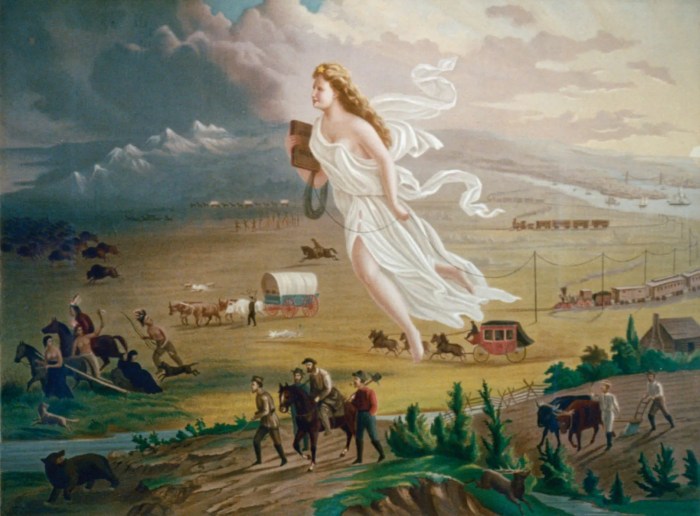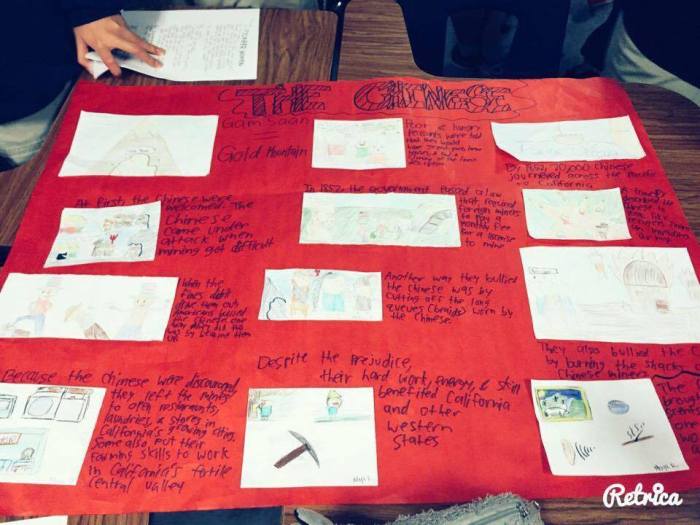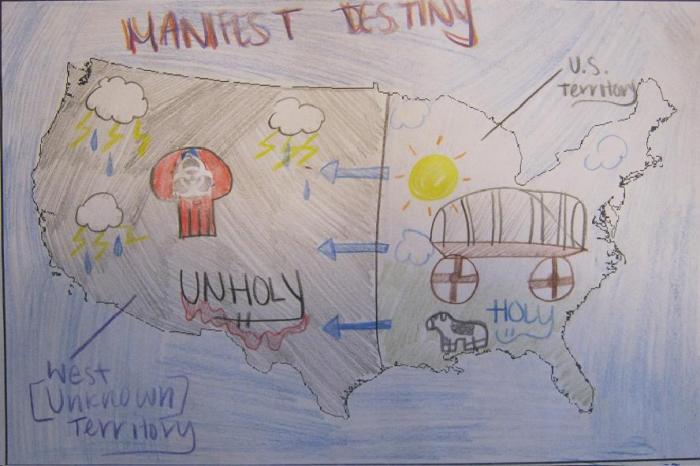Manifest Destiny art activity offers a unique lens through which to examine a pivotal period in American history. This exploration delves into the artistic representations of Manifest Destiny, analyzing how artists depicted westward expansion, its impact on Native American populations, and the resulting shaping of national identity. We’ll dissect the techniques, symbolism, and diverse perspectives embedded within these works, from Romantic landscapes to contemporary critiques.
This isn’t just about appreciating art; it’s about understanding a complex and often controversial chapter in American history.
By examining various artistic mediums – paintings, sculptures, even animation storyboards – we’ll uncover how Manifest Destiny’s narrative unfolded through the eyes of artists, both those who celebrated its progress and those who condemned its consequences. We’ll also explore how to translate this historical understanding into engaging lesson plans for K-12 classrooms, fostering critical thinking and creative expression among young learners.
Manifest Destiny in American Art
Manifest Destiny, the 19th-century belief in the divinely ordained right of the United States to expand its dominion across North America, profoundly impacted American art. Artists responded to this ideology, reflecting its triumphs and tragedies through various artistic styles and mediums. This exploration delves into how Manifest Destiny is portrayed in art, examining its artistic representations, techniques, and the diverse perspectives it evokes.
Defining Manifest Destiny in Art

Manifest Destiny is concisely defined as the 19th-century belief that the United States was destined to expand its dominion and spread democracy and capitalism across the North American continent. This belief fueled westward expansion, significantly impacting the lives of Native Americans and other marginalized groups. The historical context of Manifest Destiny deeply influenced American art, shaping its themes, styles, and narratives.
Artists often depicted the westward expansion as a glorious and inevitable process, celebrating the progress and achievements of American settlers. However, other artists later challenged this narrative, highlighting the violence and displacement inflicted upon Native American populations.
Manifest Destiny found expression in diverse artistic styles. Romantic landscapes, for instance, emphasized the grandeur and beauty of the American wilderness, often overlooking the indigenous presence. Realist paintings, on the other hand, sometimes offered a more critical perspective, depicting the harsh realities of westward expansion and the conflicts between settlers and Native Americans. Genre scenes depicted the daily lives of settlers, reinforcing the narrative of progress and self-reliance.
Identifying Artistic Representations of Manifest Destiny
Numerous artworks vividly depict Manifest Destiny. Albert Bierstadt’s monumental landscape paintings, such as “Among the Sierra Nevada, California,” showcase the awe-inspiring beauty of the American West, subtly promoting the idea of its inherent value to the United States. Other examples include Frederic Remington’s paintings and sculptures, which often depict cowboys and the romanticized image of the American frontier.
These works, while visually stunning, frequently omit the violence and displacement experienced by Native American tribes during westward expansion.
Symbolism in these representations is crucial. Vast landscapes symbolize the boundless potential of the West, while depictions of settlers moving westward represent progress and civilization. However, the absence or marginalization of Native Americans in many artworks reflects the dominant narrative that often ignored or minimized their experiences and perspectives.
Comparing and contrasting these artistic interpretations reveals a range of perspectives. Some artists celebrated the expansion, while others subtly or overtly critiqued its consequences. This divergence reflects the evolving understanding and interpretations of Manifest Destiny throughout history.
Analyzing Artistic Techniques and Styles

Artistic techniques played a vital role in shaping the perception of Manifest Destiny. Romanticism, with its emphasis on emotion and idealized landscapes, dominated early depictions, glorifying the vastness and beauty of the American West. Realism, emerging later, provided a more grounded portrayal, often showing the hardships and conflicts associated with westward expansion. The use of light and shadow, color palettes, and composition all contributed to the overall message conveyed by these artworks.
Landscape painting became a dominant genre in portraying Manifest Destiny. Artists used sweeping vistas and dramatic compositions to emphasize the grandeur of the American landscape, inviting viewers to share in the sense of awe and wonder associated with the nation’s expansion. The style chosen directly influenced viewer understanding; romantic works evoked a sense of wonder and inevitability, while realist works could evoke feelings of unease or critique.
Manifest Destiny Art Activity: A Lesson Plan
This lesson plan uses art to explore Manifest Destiny, encouraging critical thinking and diverse perspectives. The activities are designed to be adaptable to various age groups and skill levels within a K-12 setting.
| Activity | Materials | Procedure | Assessment |
|---|---|---|---|
| Creating a Landscape Depicting Westward Expansion | Paint, brushes, canvas, reference images | Students create landscapes inspired by westward expansion, considering perspectives of settlers and Native Americans. | Evaluation based on creativity, technique, and understanding of historical context. |
| Collage Representing Different Perspectives on Manifest Destiny | Various materials (paper, fabric, photographs), glue, board | Students create collages reflecting different viewpoints on Manifest Destiny, including those of settlers, Native Americans, and other marginalized groups. | Assessment based on the inclusion of diverse perspectives and creative expression. |
| Sculpting a Symbol of Manifest Destiny | Clay, sculpting tools | Students sculpt a symbol representing Manifest Destiny, discussing the symbolism and its implications. | Evaluation based on technical skill, creativity, and understanding of the chosen symbol. |
Creating Original Artwork Inspired by Manifest Destiny
Imagine a painting depicting the Trail of Tears. The composition would feature a long, winding line of Cherokee people, their faces etched with sorrow and exhaustion, moving across a bleak and barren landscape. The color palette would be muted, dominated by browns, grays, and muted blues, reflecting the hardship and despair. The symbolism would focus on the forced removal and the destruction of a culture.
A sculpture embodying the spirit of Manifest Destiny could be a bronze figure of a westward-bound pioneer, his gaze fixed on the horizon, his shoulders squared, conveying determination and ambition. The materials would emphasize strength and durability. The symbolic meaning would lie in the representation of ambition and the drive for expansion.
A storyboard for an animated film could begin with a scene showing a lush, vibrant landscape inhabited by Native Americans. The following scenes would depict the arrival of settlers, the gradual encroachment on Native American lands, and the resulting conflicts. The final scene could show a contemplative reflection on the legacy of Manifest Destiny.
Exploring Diverse Perspectives on Manifest Destiny, Manifest destiny art activity
Native American perspectives on Manifest Destiny are crucial to understanding the full impact of this ideology. For Native Americans, Manifest Destiny represented displacement, dispossession, and cultural destruction. Their narratives highlight the immense suffering and loss inflicted upon their communities. Art can challenge the dominant narrative by giving voice to these marginalized perspectives.
Art can serve as a powerful tool to critique the narrative of Manifest Destiny. Works that depict the violence, displacement, and cultural destruction experienced by Native Americans offer a counterpoint to the idealized portrayals of westward expansion. Such artwork fosters empathy and encourages critical engagement with history.
Examples of artwork offering alternative viewpoints include contemporary pieces that directly address the historical injustices associated with Manifest Destiny. These works often use powerful imagery and symbolism to convey the suffering and resilience of Native American communities.
The Impact of Manifest Destiny on American Identity

Artistic representations of Manifest Destiny played a significant role in shaping American national identity. Early depictions of westward expansion fostered a sense of national pride and exceptionalism. The vast landscapes and heroic figures reinforced the idea of America’s destiny to dominate the continent. This contributed to a narrative of progress and dominance that has had a lasting impact.
Manifest Destiny continues to influence contemporary American art and culture. Themes of expansion, progress, and the relationship between humans and nature remain central to many artistic expressions. Artists continue to engage with the legacy of Manifest Destiny, often exploring its complexities and contradictions.
Modern artwork engaging with the legacy of Manifest Destiny includes pieces that critically examine the historical narrative, highlighting the perspectives of marginalized groups and the lasting consequences of westward expansion. These works encourage reflection on the past and promote a more nuanced understanding of American history.
Final Conclusion: Manifest Destiny Art Activity
Ultimately, engaging with Manifest Destiny through art provides a powerful tool for understanding this complex historical period. By analyzing artistic interpretations, we can move beyond a simplistic narrative and grapple with the multifaceted legacies of westward expansion. Whether it’s through creating original artwork inspired by historical events or critically examining existing pieces, the exploration of Manifest Destiny’s artistic representation offers a profound and enriching experience, one that prompts reflection on American identity and its ongoing evolution.
Answers to Common Questions
What specific artistic movements heavily featured Manifest Destiny themes?
Romanticism and Realism were prominent styles used to depict Manifest Destiny, with Romanticism emphasizing the grandeur and beauty of the American landscape, while Realism often focused on the realities of westward expansion, including its harshness and impact on Native Americans.
How can I adapt a Manifest Destiny art activity for different age groups?
Adapt activities based on age and skill level. Younger students might focus on simpler projects like coloring pages or creating collages, while older students could tackle more complex tasks like painting detailed landscapes or creating sculptures with symbolic meaning.
Are there ethical considerations when teaching about Manifest Destiny in art?
Absolutely. It’s crucial to acknowledge the negative consequences of Manifest Destiny, particularly its impact on Indigenous populations. Present diverse perspectives and encourage critical analysis of the narrative, fostering empathy and understanding.